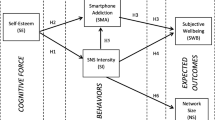Abstract
This study aims to examine the effect of social needs, social influences and convenience of smartphone on students’ dependency on smartphones. A total of 200 completed and usable questionnaires were received from the respondents which comprises of students from one of the public higher institution in Federal Territory of Labuan, Malaysia by utilizing simple random sampling method. Results via the analysis of structural equation modeling (SEM) revealed that all proposed hypotheses were supported. Social needs were found to be the strongest effect. Students heavily and actively use smartphone to stay connected with friends and family through social networking web sites such as Twitter, Facebook, MySpace and etc. Smartphone allow them to stay connected with those they care about. Based on the findings, the implications are discussed in the paper and directions for future research are also highlighted.
Access this chapter
Tax calculation will be finalised at checkout
Purchases are for personal use only
Similar content being viewed by others
References
Auter PJ (2007) Portable social groups: willingness to communicate, interpersonal communication gratifications and cell phone use among young adults. Int J Mob Commun 5(2):139–156
Carayannis EG, Clark SC, Valvi DE (2012) Smartphone affordance: achieving better business through innovation. J Knowl Econ 22(6):1–11
Davis FD (1989) Perceived usefulness, perceived ease of use and user acceptance of information technology. MIS Q 13(3):319–340
Donahue HC (2010) The network neutrality inquiry. Info 12(2):3–8
Euromonitor (2010) Smartphone: not just iPhones, but a boomerang movement. Retrieved from Euromonitor International database
Fornell C, Larcker DF (1981) Evaluating structural equation models with unobservable variables and measurement error. J Mark Res 18(1):39–50
Gartner (2012) Global mobile sales down 2 %, smartphones surge 43 %, apple stalls as fans hold out for new iPhone. http://techcrunch.com/2012/08/14/gartner-global-mobile-sales-down-2-smartphones-surge-43-apple-stalls-as-fans-hold-out-for-new-iphone/. Last accessed on 18 June 2012
Genova GL (2010) The anywhere office – anywhere liability. BCQ 73:119–126
Goldman SM (2010) Transformers. J Consum Mark 27(5):469–473
Hair JF, Black B, Babin B, Anderson RE, Tatham RL (2010) Multivariate data analysis: a global perspective. Pearson Education Inc., Upper Saddle River
Jamil B, Wong CH (2010) Factors influencing repurchase intention of smartphones. J Mark Res 4(12):289–294
Kuhlmeier D, Knight J (2005) Antecedents to internet based purchasing: a multinational study. Int Market Rev 22(4):460–473
Leech NL, Onwuegbuzie AJ (2009) A typology of mixed methods research designs. Qual Quant 43:265–275
Mason WA, Conrey FD, Smith ER (2007) Situating social influence processes: dynamic, multidirectional flows of influence within social networks. Pers Soc Psychol Rev 11(3):279–300
Mei M, Chow LH, Chen JA, Yeow P, Wong W (2012) Conceptual paper: factors affecting the demand of smartphone among young adult. Int J Soc Sci Econ Art 10(2):332–334
Miller K, Mont D, Maitland A, Altman B, Madans J (2011) Results of a cross-national structured cognitive interviewing protocol to test measures of disability. Qual Quant 45:801–815
Park HW (2012) Examining academic internet use using a combined method. Qual Quant 46:251–266
Park Y, Chen JV (2007) Acceptance and adoption of the innovative use of smartphone. Ind Manag Data Syst 107(9):1349–1365
Persaud A, Azhar I (2012) Innovative mobile marketing via smartphones: are consumers ready? Mark Intell Plann 30(4):3–36
Peterson L, Low B (2011) Student attitudes towards mobile library services for smartphone. Libr Hi Tech 29(3):412–423
Schiffman LG, Kanuk LL, Wisenbut J (2009) Consumer behavior, 10th edn. Pearson Education Inc., Upper Saddle River
Seitz A (1993) The political dimension of intercultural research: the Australian experience. Qual Quant 27:411–420
Smura T, Kivi A, Toyli J (2009) A framework for analysing the usage of mobile services. INFO J Policy Regul Strategy Telecommun Inf Media 11(4):53–67
Suki NM, Suki NM (2007) Mobile phone usage for M-learning: comparing heavy and light mobile phone users. Campus Wide Inf Syst 24(5):355–365
Tian L, Shi J, Yang Z (2009) Why does half the world’s population have a mobile phone? an examination of consumers’ attitudes toward mobile phones. CyberPsychol Behav 12(5):513–516
Ting DH, Lim SF, Patanmacia TS, Low CG, Ker GC (2011) Dependency on smartphone and the impact on purchase behavior. Young Consum 12(3):193–203
Woodcock B, Middleton A, Nortcliffe A (2012) Considering the smartphone learner: an investigation into student interest in the use of personal technology to enhance their learning. Stud Engage Exp J 1(1):1–15
Author information
Authors and Affiliations
Corresponding author
Editor information
Editors and Affiliations
Rights and permissions
Copyright information
© 2013 Springer-Verlag Berlin Heidelberg
About this chapter
Cite this chapter
Suki, N.M., Suki, N.M. (2013). Effects of Social Needs, Social Influences and Convenience on Smartphones Dependency. In: Chuan, P., Khachidze, V., Lai, I., Liu, Y., Siddiqui, S., Wang, T. (eds) Innovation in the High-Tech Economy. Contributions to Economics. Springer, Berlin, Heidelberg. https://doi.org/10.1007/978-3-642-41585-2_13
Download citation
DOI: https://doi.org/10.1007/978-3-642-41585-2_13
Published:
Publisher Name: Springer, Berlin, Heidelberg
Print ISBN: 978-3-642-41584-5
Online ISBN: 978-3-642-41585-2
eBook Packages: Business and EconomicsBusiness and Management (R0)




